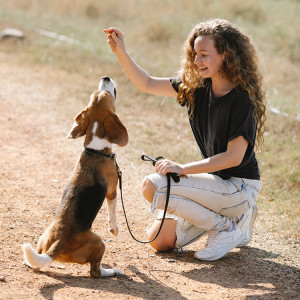What Is Rage Syndrome?
It might be very rare, but its still worth knowing about
Rage syndrome is a rare disorder where a dog may suddenly display intense aggression without any clear warning and seemingly unprovoked. These frightening episodes, often directed at their pet parents, can escalate into biting, leaving families not only shaken but concerned for their safety.
For pet parents, understanding aggression in dogs isn’t just important – it’s essential. After all, our four-legged friends share our homes and, of course, our hearts. Ensuring everyone’s safety means taking the time to understand what is behind these behaviours and how we can foster a calm, happy and secure environment for both our pets and their people.
What is rage syndrome in dogs?
Aggression in dogs can stem from many causes, and most aren’t linked to rage syndrome. So what is rage syndrome in dogs? The rare disorder (also known as Idiopathic Aggression, Episodic Dysfunction Syndrome or Low Threshold Aggression), is poorly understood both publicly and professionally, and has been historically thought to involve neurological dysfunction, causing sudden, intense bouts of unprovoked aggression in dogs that are otherwise friendly and calm.
Unlike other types of aggression – such as resource guarding, fear-based reactivity or painopens in new tab – rage syndrome episodes often appear out of the blue, with no preceding warning signs like growling or showing teeth. There are even instances where dogs with rage syndrome were found to have neurological issues, such as temporal lobe epilepsy, and some showed improvement with anti-epileptic medicationopens in new tab.
What are the signs of rage syndrome in dogs?
As rage syndrome is such a rare disorder, many dogs initially suspected of having it are later found to have aggression triggered by other causes. That said, the following are signs commonly linked to rage syndrome:
episodes of sudden, unpredictable aggression
episodes occurring without provocation, often after waking
no apparent guilt after an episode, returning to normal as if nothing happened
or, the dog may appear confused or dazed after an episode
little to no warning signs, such as growling or showing their teeth
fixed staring or excessively dilated pupils
To compare, here are some common triggers of aggression unrelated to rage syndrome:
fear or anxiety
resource guarding (eg, food or toys)
conflict
pain
predatory behaviour
protectiveness
territorial behaviour
Does my dog have rage syndrome?
Given the overlap in signs, how can you tell if your dog might have rage syndrome? Start by keeping a detailed log of aggressive episodes, noting any possible triggers. Share this information with your vet, who will rule out other medical causes, such as pain or epilepsy. After seizures, for example, dogs can enter a postictal stage, where disorientation due to being unaware of their surroundings and not recognising loved ones may lead to aggressive behaviour.
Your vet may then refer you to a specialist, such as an Animal Behaviour and Training Council (ABTC)-registered behaviourist, such as a Clinical Animal Behaviourist, Veterinary Behaviourist or Accredited Animal Behaviourist. They will be able to work together with you and your pet alongside your vet to help with any behavioural issues including aggression.
Are some breeds more susceptible to rage syndrome?
While rage syndrome is rare, certain breeds do seem to be more predisposed. Historically, Cocker Spaniels and Springer Spaniels have been most associated with the disorder, to the point that terms such as “Cocker Rage” and “Springer Rage” have entered into canine vernacular. However, the condition was first identified in a Belgian Malinois, and other breeds, such as Belgian Malinois, German Shepherds, Staffordshire Bull Terriers and Dobermans, have also been linkedopens in new tab.
Due to the possible genetic link it may also be found in descendants of affected animals and their crosses. While a genetic or breed-related component is suspected, it’s important to consider the popularity of these breeds during early studies. Spaniels, for instance, were one of the most popular breeds in the UK when the condition was first documented, which may have skewed findingsopens in new tab.
Treatment for rage syndrome in dogs
While rage syndrome cannot be fully cured, it can be managed. Behavioural management strategies include:
Training: build trust and establish desired behaviours through positive reinforcement.
Environment: minimise stressors such as loud noises or unfamiliar visitors to create a safe, consistent routine.
Enrichment: mental and physical stimulation such as snuffle mats, hide-and-seek games and puzzle toys.
For some dogs, veterinary-prescribed medication can help alleviate anxiety and reduce aggression. Unfortunately, in rare and severe cases where aggression presents significant safety risks, euthanasia may be considered. Each case is different to each individual dog, so thorough investigation and professional input is necessary to find the best treatment for each patient.
Managing dogs with rage syndrome
Safety precautions are most important with any type of aggression in pets, here are some tips that may help:
Creating a safe space, where your dog is not disturbed and can retreat to.
Muzzle training for use in potentially stressful situations.
Educate family members on how to interact safely and develop a plan for managing aggressive episodes.
Always seek professional advice if aggression is seen.
Experiencing aggression from a dog especially if it is your own can be very distressing and emotionally challenging. It’s crucial to reach out to your vet and/or a qualified behaviourist for advice and support – you don’t have to navigate this alone.
Prevention and ethical breeding practices
As rage syndrome is thought to have a genetic component, ethical breeding practices are critical. Dogs showing aggression should not be bred, as this risks passing the trait to their offspring.
When looking into getting a dog, research each breed carefully for what they were originally bred for and their typical behaviours, and importantly observe how the dam (mother) and sire (father) behave if getting a puppy from a breeder before taking them home.
Rage syndrome is a rare but serious condition characterised by sudden, unprovoked aggression. Unlike other forms of aggression triggered by pain, fear or territorial instincts, rage syndrome episodes seem to arise without cause, often targeting family members.
If you’re concerned your dog may have rage syndrome or have noticed sudden aggressive behaviour, consult a vet or animal behaviourist. With expert advice, thorough investigation, and a tailored management plan, you can help keep both your pet and loved ones safe.
Resources
The influence of inheritance and environment on canine behaviour: myth and factopens in new tab, Journal of Small Animal Practice, 1987
Aggressive behavior in the English cocker spanielopens in new tab. Journal of Veterinary Behavior, 2009











